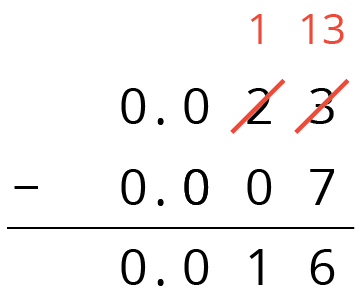Lesson 3
Adding and Subtracting Decimals with Few Non-Zero Digits
Let’s add and subtract decimals.
3.1: Do the Zeros Matter?
-
Evaluate mentally: \(1.009+0.391\)
-
Decide if each equation is true or false. Be prepared to explain your reasoning.
- \(34.56000 = 34.56\)
- \(25 = 25.0\)
- \(2.405 = 2.45\)
3.2: Calculating Sums
-
Andre and Jada drew base-ten diagrams to represent \(0.007 + 0.004\). Andre drew 11 small rectangles. Jada drew only two figures: a square and a small rectangle.

- If both students represented the sum correctly, what value does each small rectangle represent? What value does each square represent?
- Draw or describe a diagram that could represent the sum \(0.008 + 0.07\).
-
Here are two calculations of \(0.2 + 0.05\). Which is correct? Explain why one is correct and the other is incorrect.

- Compute each sum. If you get stuck, consider drawing base-ten diagrams to help you.
-
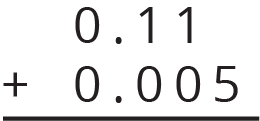
- \(0.209 + 0.01\)
- \(10.2 + 1.1456\)
-
- The applet has tools that create each of the base-ten blocks. This time you need to decide the value of each block before you begin.
- Select a Block tool, and then click on the screen to place it.
- Click on the Move tool (the arrow) when you are done choosing blocks.
- Subtract by deleting with the delete tool (the trash can), not by crossing out.
3.3: Subtracting Decimals of Different Lengths
To represent \(0.4 - 0.03\), Diego and Noah drew different diagrams. Each rectangle represented 0.1. Each square represented 0.01.
-
Diego started by drawing 4 rectangles to represent 0.4. He then replaced 1 rectangle with 10 squares and crossed out 3 squares to represent subtraction of 0.03, leaving 3 rectangles and 7 squares in his diagram.
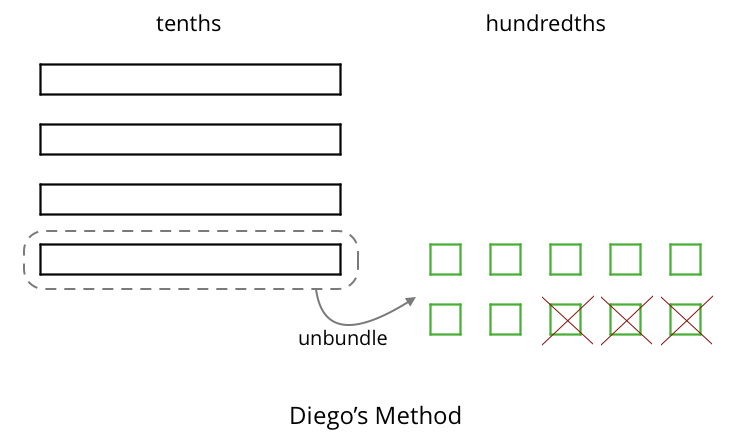
-
Noah started by drawing 4 rectangles to represent 0.4. He then crossed out 3 of rectangles to represent the subtraction, leaving 1 rectangle in his diagram.
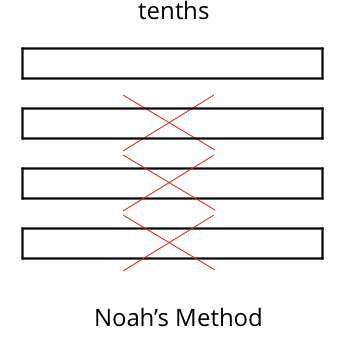
-
Do you agree that either diagram correctly represents \(0.4 - 0.03\)? Discuss your reasoning with a partner.
-
To represent \(0.4 - 0.03\), Elena drew another diagram. She also started by drawing 4 rectangles. She then replaced all 4 rectangles with 40 squares and crossed out 3 squares to represent subtraction of 0.03, leaving 37 squares in her diagram. Is her diagram correct? Discuss your reasoning with a partner.
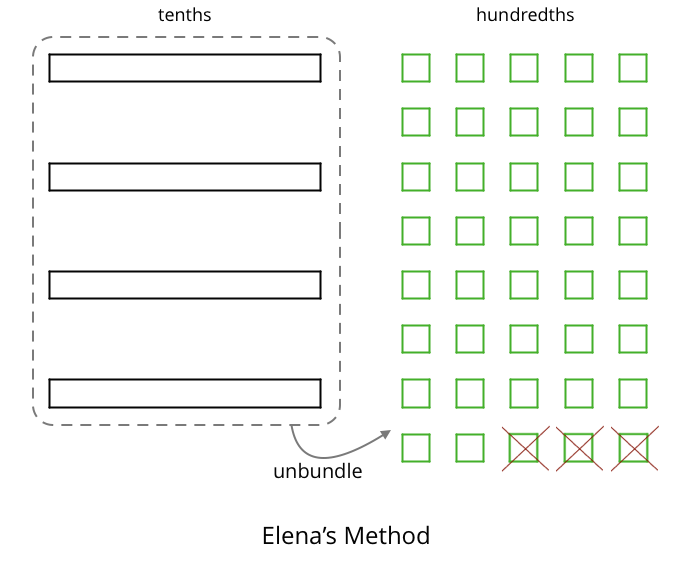
- Find each difference. If you get stuck, you can use the applet to represent each expression and find its value.
- \(0.3 - 0.05\)
- \(2.1 - 0.4\)
- \(1.03 - 0.06\)
- \(0.02 - 0.007\)
Be prepared to explain your reasoning.
- The applet has tools that create each of the base-ten blocks. This time you need to decide the value of each block before you begin.
- Select a Block tool, and then click on the screen to place it.
- Click on the Move tool (the arrow) when you are done choosing blocks.
- Subtract by deleting with the delete tool (the trash can), not by crossing out.
A distant, magical land uses jewels for their bartering system. The jewels are valued and ranked in order of their rarity. Each jewel is worth 3 times the jewel immediately below it in the ranking. The ranking is red, orange, yellow, green, blue, indigo, and violet. So a red jewel is worth 3 orange jewels, a green jewel is worth 3 blue jewels, and so on.
At the Auld Shoppe, a shopper buys items that are worth 2 yellow jewels, 2 green jewels, 2 blue jewels, and 1 indigo jewel. If they came into the store with 1 red jewel, 1 yellow jewel, 2 green jewels, 1 blue jewel, and 2 violet jewels, what jewels do they leave with? Assume the shopkeeper gives them their change using as few jewels as possible.
Summary
Base-ten diagrams can help us understand subtraction as well. Suppose we are finding \(0.23 - 0.07\). Here is a diagram showing 0.23, or 2 tenths and 3 hundredths.

Subtracting 7 hundredths means removing 7 small squares, but we do not have enough to remove. Because 1 tenth is equal to 10 hundredths, we can “unbundle” (or decompose) one of the tenths (1 rectangle) into 10 hundredths (10 small squares).

We now have 1 tenth and 13 hundredths, from which we can remove 7 hundredths.

We have 1 tenth and 6 hundredths remaining, so \(0.23 - 0.07 = 0.16\).

Here is a vertical calculation of \(0.23 - 0.07\).
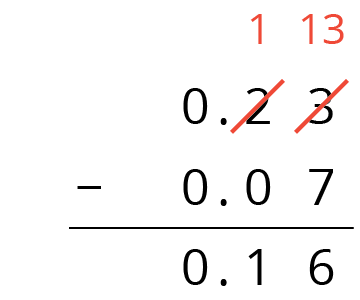
Notice how this representation also shows a tenth is unbundled (or decomposed) into 10 hundredths in order to subtract 7 hundredths.
This works for any decimal place. Suppose we are finding \(0.023 - 0.007\). Here is a diagram showing 0.023.

We want to remove 7 thousandths (7 small rectangles). We can “unbundle” (or decompose) one of the hundredths into 10 thousandths.

Now we can remove 7 thousandths.

We have 1 hundredth and 6 thousandths remaining, so \(0.023 - 0.007 = 0.016\).

Here is a vertical calculation of \(0.023 - 0.007\).
